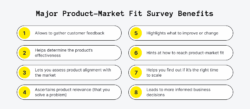In today’s competitive market, understanding your customers is no longer an option, it’s a necessity. Your customer support team is often the direct link to your customers’ experiences, making their interactions crucial. Knowing how well your support team is performing can mean the difference between loyal advocates and lost business, and the best way to gain this insight is by simply asking.
Gathering feedback helps you pinpoint what’s working, what’s not, and where improvements can be made. This proactive approach not only helps you fix immediate issues but also builds a foundation for long-term customer relationships. It empowers you to refine your services, ensuring that every customer interaction leaves a positive impression and reinforces their trust in your brand.
Understanding the Power of a Well-Crafted Customer Support Survey
A thoughtfully designed customer support survey isn’t just a collection of questions; it’s a strategic tool that unlocks vital insights into your customer service quality. Think of it as your direct line to understanding the real impact of your support interactions. By consistently deploying these surveys, you can move beyond assumptions and base your service improvements on concrete data. This allows you to identify specific pain points customers might be experiencing, whether it’s long wait times, unhelpful resolutions, or a general lack of empathy from support agents.
Moreover, these surveys serve as an invaluable resource for empowering your support agents. When agents receive constructive feedback, they can better understand their strengths and areas for development. This doesn’t just improve individual performance; it fosters a culture of continuous learning and excellence within the entire support team. Imagine the boost in morale when agents see their efforts recognized, or when they’re given clear pathways to enhance their skills, all based on genuine customer feedback.
Utilizing a reliable customer support satisfaction survey template ensures you’re asking the right questions every time. It saves you from starting from scratch, guarantees consistency across all feedback collection, and helps you cover all the critical aspects of the customer experience. This consistency is key for tracking performance trends over time and making data-driven decisions about training, staffing, and process improvements. It’s about building a robust system that continually refines your customer interactions.
The true power lies in converting the collected data into actionable strategies. A survey isn’t just for gathering numbers; it’s about what you do with those numbers. Perhaps your survey reveals a consistent issue with first-contact resolution. This insight then prompts you to invest in better agent training or more comprehensive knowledge bases. Or maybe customers consistently praise the friendly demeanor of your team, indicating that these positive traits should be reinforced and celebrated. It’s this cycle of feedback, analysis, and action that truly elevates your customer support.
Key Elements to Include in Your Survey
When building your ideal customer support satisfaction survey template, consider incorporating these essential components to capture a comprehensive view of the customer experience:
- Customer Satisfaction Score (CSAT) Question: This is often a direct “How satisfied were you with your recent support experience?” question, usually answered on a scale of 1-5 or 1-7, or with “satisfied” and “dissatisfied” options. It provides an immediate snapshot of contentment.
- Customer Effort Score (CES) Question: Focuses on how easy it was for the customer to resolve their issue. Questions like “How easy was it to resolve your issue today?” with a scale from “very difficult” to “very easy” help identify friction points in the support journey.
- Net Promoter Score (NPS) Question: Although broader, asking “How likely are you to recommend our company to a friend or colleague?” on a 0-10 scale can indicate overall customer loyalty stemming from their support experience.
- Open-Ended Feedback: Always include a text box for customers to elaborate on their experience in their own words. This qualitative data is gold, providing context and specific details that quantitative scores might miss. It allows customers to share suggestions, criticisms, and praise freely.
- Agent Performance Specifics: Questions about the support agent’s knowledge, friendliness, and efficiency can offer direct feedback for coaching and development. For instance, “Did the agent clearly understand your issue?” or “Was the agent polite and helpful?”
Designing Your Survey: Best Practices and Question Types
When you set out to design your customer support survey, remember that brevity is your friend. People are busy, and a long, complicated survey can lead to abandonment and low response rates. Aim for conciseness while still gathering the necessary insights. Think about the specific moment you want to capture feedback. Is it immediately after a support interaction, or a few hours later? The timing can significantly impact the relevance and accuracy of the responses you receive, so consider what makes the most sense for your service model and the customer’s journey.
It’s also crucial to select the right question types to elicit the most valuable information. While rating scales like Likert scales (e.g., “strongly agree” to “strongly disagree”) are excellent for quantifying sentiment and tracking changes over time, don’t shy away from multiple-choice questions for specific scenarios or demographic information. These can help categorize responses more easily and provide clearer data points for analysis. The blend of quantitative and qualitative questions is key to getting a full picture.
Making the survey accessible across various channels is another best practice you shouldn’t overlook. Whether it’s through email invitations, in-app prompts, SMS links, or even QR codes on physical documents, ensure your customers can easily find and complete the survey on their preferred device. A seamless survey experience contributes to higher completion rates and demonstrates that you value their time and feedback, making it more likely they will engage with future feedback requests.
Finally, and perhaps most importantly, is the commitment to acting on the feedback you receive. A survey is only as valuable as the changes it inspires. Regularly review the responses, identify recurring themes, and share insights with your team. Use this data to implement targeted improvements, whether it’s refining processes, providing additional training, or celebrating successes. This continuous loop of listening and improving shows your customers that their voices matter, fostering a stronger, more trusting relationship and ensuring your support continually evolves for the better.
Collecting customer feedback is more than just a task; it’s a strategic investment in the future of your business. By consistently measuring satisfaction and acting on the insights, you’re not just improving service; you’re building a reputation for excellence that resonates deeply with your audience. This ongoing dedication to understanding and meeting customer needs will undoubtedly set you apart.
Embracing this proactive approach allows you to transform challenges into opportunities for growth and loyalty. The effort you put into listening will translate directly into a stronger, more resilient customer base, ensuring that your business continues to thrive by putting the customer at its very core.



